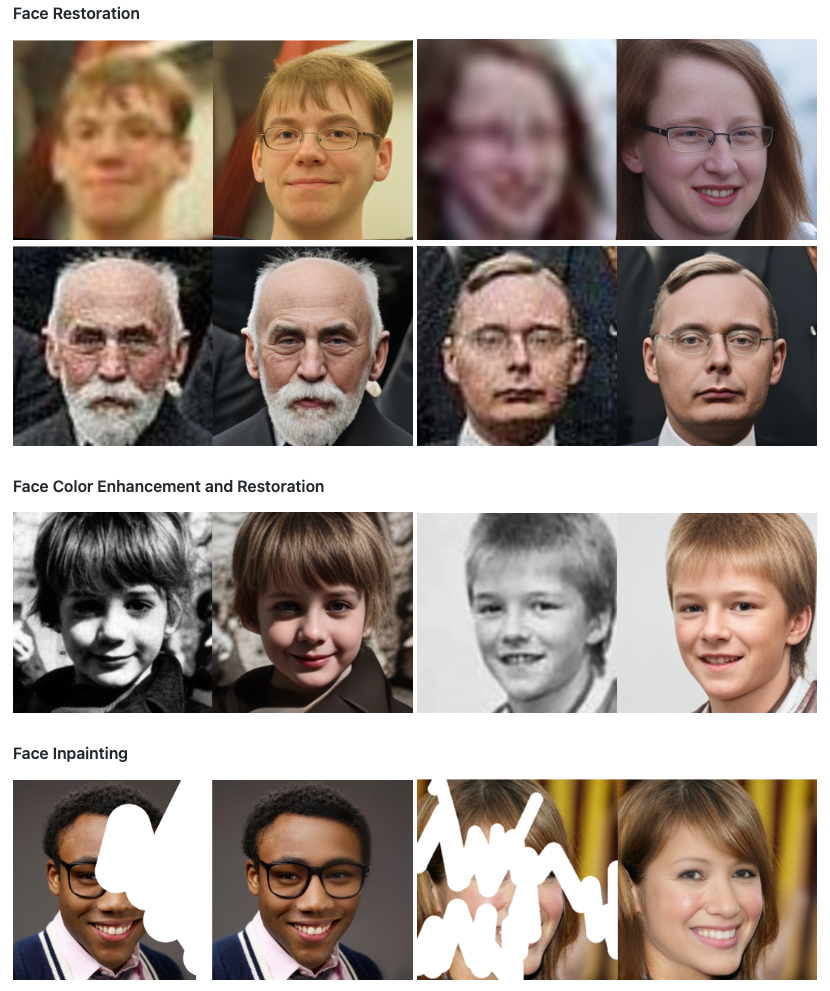This repo shows a step by step tutorial on how to apply this algorithm to videos downloaded from YouTube in order to restore and improve the image quality and detail of the faces found in the frames.
- SageMaker StudioLab Explainer Video
- Explainer Video about RealBasicVSR
- Towards Robust Blind Face Restoration with Codebook Lookup Transformer
- CodeFormer Official Repo
- It Happened One Frame: incredibly accurate video content search with OpenAI CLIP
You can follow this step by step tutorial either through Amazon SageMaker StudioLab, Google Colab, or on your own hardware. Please click in any of the links below to get started
In order to setup your SMSL environment, you will need to get a SageMaker Studio Lab account. This is completely free and you don't need an AWS account. Because this is still in Preview and AWS is looking to reduce fraud (e.g., crypto mining), you will need to wait 1-3 days for your account to be approved. You can see this video for more information. Otherwise, you can also use Google Colab which provides free GPU compute (NVIDIA T4/K80).
We are going to be re-using some of YiYi Xu's code shown here in this article and its HF Space.
def process_video_parallel(video, skip_frames, dest_path, num_processes, process_number, **kwargs):
cap = cv2.VideoCapture(video)
frames_per_process = int(cap.get(cv2.CAP_PROP_FRAME_COUNT)) // (num_processes)
count = frames_per_process * process_number
cap.set(cv2.CAP_PROP_POS_FRAMES, count)
while count < frames_per_process * (process_number + 1) :
ret, frame = cap.read()
if not ret:
break
if count % skip_frames == 0:
filename =f"{dest_path}/{count:06d}.png"
cv2.imwrite(filename, frame)
count += 1
cap.release()def vid2frames(url, sampling_interval=1, **kwargs):
# create folder for extracted frames - if folder exists, delete and create a new one
path_frames = create_dir('frames')
# download the video
fps, video_location = download_video(url)
if video_location is not None:
if fps is None: fps = 30
skip_frames = int(fps * sampling_interval)
if skip_frames == 0: skip_frames += 1
print(f'video saved at: {video_location}, fps:{fps}, skip_frames: {skip_frames}')
# extract video frames at given sampling interval with multiprocessing -
n_workers = min(os.cpu_count(), 12)
with Pool(n_workers) as pool:
pool.map(partial(process_video_parallel, video_location, skip_frames, path_frames, n_workers), range(n_workers))
else:
skip_frames, path_frames = None, None
return (fps, video_location, path_frames)We set sampling_interval to 0 in order to sample all frames in a video.
fps, video_location, path_frames = vid2frames(youtube_url, sampling_interval=0)def process_frame_parallel(img_path):
# clean all the intermediate results to process the next image
face_helper.clean_all()
img_name = os.path.basename(img_path)
# print(f'Processing: {img_name}')
basename, ext = os.path.splitext(img_name)
img = cv2.imread(img_path, cv2.IMREAD_COLOR)
if args.has_aligned:
# the input faces are already cropped and aligned
img = cv2.resize(img, (512, 512), interpolation=cv2.INTER_LINEAR)
face_helper.cropped_faces = [img]
else:
face_helper.read_image(img)
# get face landmarks for each face
num_det_faces = face_helper.get_face_landmarks_5(
only_center_face=args.only_center_face, resize=640, eye_dist_threshold=5)
# print(f'\tdetect {num_det_faces} faces')
# align and warp each face
face_helper.align_warp_face()
# face restoration for each cropped face
for idx, cropped_face in enumerate(face_helper.cropped_faces):
# prepare data
cropped_face_t = img2tensor(cropped_face / 255., bgr2rgb=True, float32=True)
normalize(cropped_face_t, (0.5, 0.5, 0.5), (0.5, 0.5, 0.5), inplace=True)
cropped_face_t = cropped_face_t.unsqueeze(0).to(device)
try:
with torch.no_grad():
output = net(cropped_face_t, w=w, adain=True)[0]
restored_face = tensor2img(output, rgb2bgr=True, min_max=(-1, 1))
del output
torch.cuda.empty_cache()
except Exception as error:
print(f'\tFailed inference for CodeFormer: {error}')
restored_face = tensor2img(cropped_face_t, rgb2bgr=True, min_max=(-1, 1))
restored_face = restored_face.astype('uint8')
face_helper.add_restored_face(restored_face)
# paste_back
if not args.has_aligned:
# upsample the background
if bg_upsampler is not None:
# Now only support RealESRGAN for upsampling background
bg_img = bg_upsampler.enhance(img, outscale=args.upscale)[0]
else:
bg_img = None
face_helper.get_inverse_affine(None)
# paste each restored face to the input image
restored_img = face_helper.paste_faces_to_input_image(upsample_img=bg_img, draw_box=args.draw_box)
# save restored img
if not args.has_aligned and restored_img is not None:
save_restore_path = os.path.join(result_root, 'final_results', f'{basename}.png')
imwrite(restored_img, save_restore_path)We then run this in parallel
from tqdm.contrib.concurrent import process_map, thread_map # or thread_map
original_frames = sorted(glob.glob(f'{path_frames}/*.png'))
results = thread_map(process_frame_parallel, original_frames), max_workers=1)restored_frames = sorted(glob.glob(f'{result_root}/final_results/*.png'))
img_array = thread_map(read_image, restored_frames)generated_video_no_audio = f'videos/{Path(video_location).stem}_restored_no_audio.mp4'
generated_video = f'videos/{Path(video_location).stem}_restored.mp4'
img = cv2.imread(restored_frames[0])
height, width, layers = img.shape
size = (width, height)
out = cv2.VideoWriter(generated_video_no_audio, cv2.VideoWriter_fourcc(*'mp4v'), fps, size)
for i in tqdm(range(len(img_array))):
out.write(img_array[i])
out.release()Finally, we use ffmpeg to combine several audio and video files into one as described in this article.
# source:
!ffmpeg -i $video_location -i $generated_video_no_audio -c copy -map 1:v:0 -map 0:a:0 -shortest $generated_video@article{zhou2022codeformer,
author = {Zhou, Shangchen and Chan, Kelvin C.K. and Li, Chongyi and Loy, Chen Change},
title = {Towards Robust Blind Face Restoration with Codebook Lookup TransFormer},
journal = {arXiv preprint arXiv:2206.11253},
year = {2022}
}
- The content provided in this repository is for demonstration purposes and not meant for production. You should use your own discretion when using the content.
- The ideas and opinions outlined in these examples are my own and do not represent the opinions of AWS.

